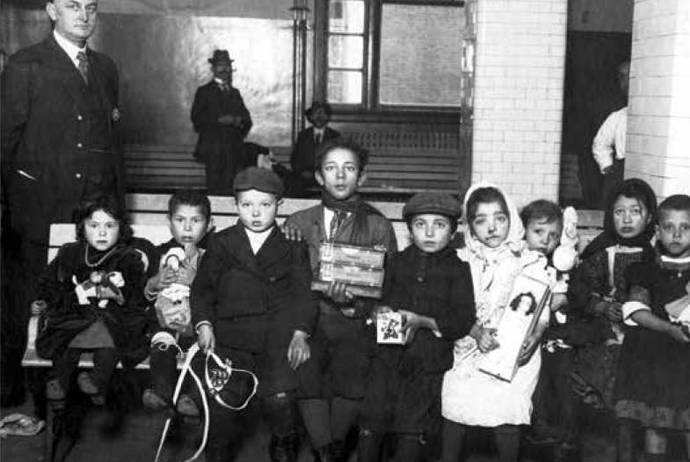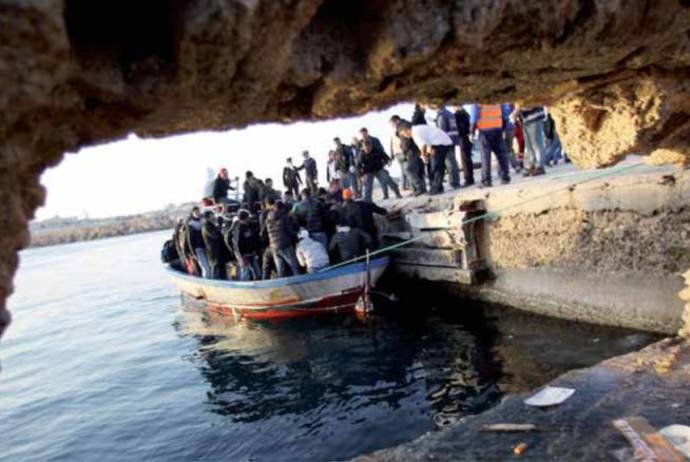It is difficult to affirm how much Joseph Petrosino was aware of the real meaning of the Mafia as a criminal organization, at the eve of his fateful trip to Sicily.
He knew only the elements he has developed during his experience in the United States, by analyzing dozens of cases concerning this particular form of crime.
The repeated arrests, which he had operated since the famous case of the man in the barrel in
1903, even though they were often undermined by an extremely assured judiciary body , had given him the impression that the war could be won; and this, of course, can explain the courage and boldness he daily used to show towards crude and violent men.
America, however, was very different from Sicily. Two continents, two different worlds. In the United States, even though confined at beginning to the Italian areas named Little Italy and Brooklyn, the Mafia actions and extortions did not gain social consensus, and they were often hindered by the large number of Mutual Aid Societies, which were arisen also to push local authorities to prosecute small and big criminals.
In Sicily, the local situation was very different. The Mafia was an implemented power which was considered as an alternative to the political institutions. The silent acceptance of the rules established by the Mafia shown by the people living in the western and internal parts of the island contributed to strengthen the organization, while the State appeared colluded with criminals through its central and local agencies.
In America, Petrosino tried to explain that the so-called Black Hand was not a unique and structured organization, but a simple acronym invented by someone who had made experiences of anarchy in the Balkans. And later this symbol has been used by small gangs – which were often in conflict among them for reaching the control over the territory.
He explained also that these criminals were refused by their own community. Thus, they were too weak and not able to be successful in America, the most modern country in the wordl.
Petrosino knew that , some time, the American police was affected by collusion with criminal gangs as well, and this was confirmed by the events which occurred in New Orleans during the tragic murder of the local police chief and the subsequent execution of eleven innocent Sicilians.
However, he was convinced that the system was healthy enough and that the efficient American democracy – which he immensely admired – was sufficient to give him the necessary tools and equipments to solve the problem.
We cannot know exactly about the opinion which Petrosino had developed about Italy and Sicily, before leaving the US to reach his home country. The mission he was entrusted with the collection of direct information and, above all, the recruitment of a local secret and trusted team of infòrmants, explane his very suspicious behavior towards the Italian authorities in general and to law enforcement bodies in Sicily in particular.
However, he didn’t know how much the situation was dangerous for him. Of course, he was offended when he discovered, once arrived in Rome, that The New York Herald, as well as other European newspapers had revealed the starting of his own mission, but, at the same time, he could understand that this was due to the electoral aims of his beloved boss, who had revealed everything to the press.
Even though he travelled under a secret name, he was very popular at that time and was immediately recognized in Italy, at first in Rome, then in his hometown, Padula, where a small crowd was waiting for celebrating the famous “paesano”. Even in Palermo, at the Oreto restaurant in Piazza Marina, where he used to have meals, he realized that two men – who had to come back from US because of his prosecution - noticed and recognized him. Neitherless, he didn’t change his behavior.
He decided to reject the polìce escort offered by the Chief Prosecutor of Palermo and continued to contact his infòrmants in a fearless way. Under these conditions, his fate was marked and the five gunshots he received near the restaurant Oreto at Piazza Marina on the evening of March 12, 1909, were an inevitable end of his destiny.
There is, however, an element which, in our view, explains better than the others, the causes of his murder. It is the deepness of the investigations on the Sicilian criminal organization, made by Petrosino, even though in so short time.
Through his notes , it is possible to understand that his attention was focused on Vito Cascio Ferro who he had known and investigated in America. He was suspected of having been the executor of the murder of the barrel, and thus , forced to return to Sicily. According the Petrosino’s note book, probably, Cascio Ferro was expected to meet him in Piazza Marina that night on March 12th.
In the island, Don Vito Cascio Ferro, after his return from the US, had rapidly increased his personal power within the organization and by using a gentleman approach, in 1909, had become the recognized leader of the Sicilian Mafia.
He used to attend parties given by rich families in Palermo and he was the leader of an extensive political organization which was able to elect a designed member of parliament in the area of Bivona: Hon. Domenico Michele Ferrantelli.
It is important to clarify that Don Vito Cascio Ferro as a Mafia leader had no necessity to raise local politicians for obtaining profits and favors.
He was able to create his own political representation within the legal institutions, and his bargaining capacity was equal to the one expressed by contemporary Mafia leaders who are no more subordinated to politicians due to the increasing drug trafficking and can build their own structure.
Well, as it’s widely known, the new polìce chief in Palermo, Baldassarre Ceola, born in Trento and recently transferred from Milan, started to investigate on Vito Cascio Ferro and his subordinates, by putting them under detailed and reasoned indictment acts.
Unluckly, they were judged by an extremely weak judiciary body which, two years after the assassination, released them from prison and discharge for lack of evidence.
Many years after, in 1926, Vito Cascio Ferro was arrested and sentenced to life imprisonment for other crimes, within the prefect Cesare Mori operations. As far as he had nothing to lose, proudly confessed that he had killed Petrosino.
Anyway, these events are too known to be discussed. What is important to underline now is that the honest Police chief of Palermo, who had collected and examined the Petrosino files, during his first reports to higher authorities, made it clear that the investigations made by the American detective revealed collusion of the mafia with the leading State institutions and that this aspect urgently needed to be examined.
The false alibi provided by Cascio Ferro, according to which, he have spent the evening of March 12 at the elections party given by Michele De Ferrantelli was confirmed by the Honorable himself and by some politicians who attended the same event.
Ceola chose not to mention this in the record of complaint delivered to the indictments division. The crucial event of the investigation was, however, determined by the zeal with which he had gathered information and evidence against the accused people and the commìtment shown during the investigation, despite the fact that the Prosecution section had already started its work.
On 17 July 1909, three months after Petrosino’death, Baldassarre Ceola received a telegram sent by the Ministry of Internal Affairs: he was released from office and recalled back to Rome.
A few days later, he retired with the honorary title of Prefect of the Kingdom. Nine months later , on April 1 , 1913, he died.
After the Chief’s removal, the Petrosino file disappeared and was not taken into account by the Prosecution Section. Vito Cascio – who appeared as a martyr who had been unjustly persecuted - was released from prison and resumed his place at the top of the mafia organization.
One hundred years later, we are here trying to develop an interpretation based on historical analysis and we need to emphasize the remarkable similarity between the events which occurred to Baldassarre Ceola and the ones happened to the Prefect Cesare Mori. The latter was arrived in Sicily, in the second half of 1920s, for fighting against the Mafia. He succeeded in eliminating several mafiosi and – as we said – he have obtained a life sentence of Vito Cascio Ferro for new crimes. Moreover, he was going to reveal the links of the mafia with the so-called "third level" ( at that time, he accused also the Fascist Federal Officer in Palermo and a Sicilian Member of the Parliament to be in collusion with mafia organization) .
Suddenly, on June 16, 1929, he was asked to retire and, few months after, sent to lead a land rehabilitation agency in Friuli, on the extremally north part of Italy.
Well, locking and comparing with attention at all these events, it’s possible to affirm that the tragic fate of Joe Petrosino is not so different from contemporary heroes such as Carlo Alberto Dalla Chiesa, Giovanni Falcone and Paolo Borsellino, who also started to unlock the secrets of the organization and pursue its leaders.
Like Petrosino, they have been brutally murdered along with other innocents as a result of plots that reveal political and institutional collusion .
What is the meaning of all these events? Maybe that, since Petrosino’s death until now, the fight against the Mafia in Sicily has not taken a step forward ? Maybe no.
The level of social consensus assured to organized crime by the Sicilian community is greatly decreased and the fight against the Mafia made by determined and courageous men, like the Prosecutor Grasso is helped by the political and social climate existing in the island after the tragic events of the more recent years.
Neitherless, the perverse logic of a political system which appears still uneven and far from genuine democracy, still is a great obstacle to the generous attempts for eradicating the Mafia and its complicity. Even today, like yesterday, the situation needs to be constantly controlled by all those people - and they now are numerous - who are fully aware that the war can be won only through the strict respect of the principle of the rule of law , even in the most insignificant aspects of the often exhausting social and political life in Sicily.


































